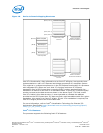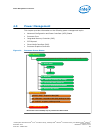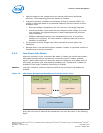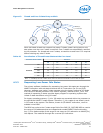
extensions to achieve the performance of fine-grain locking while actually
programming using coarse-grain locks. Details on Intel TSX-NI are in the Intel
®
Architecture Instruction Set Extensions Programming Reference.
Intel
®
64 Architecture x2APIC
The x2APIC architecture extends the xAPIC architecture that provides key
mechanisms for interrupt delivery. This extension is primarily intended to increase
processor addressability.
Specifically, x2APIC:
• Retains all key elements of compatibility to the xAPIC architecture:
— Delivery modes
— Interrupt and processor priorities
— Interrupt sources
— Interrupt destination types
• Provides extensions to scale processor addressability for both the logical and
physical destination modes
• Adds new features to enhance performance of interrupt delivery
• Reduces complexity of logical destination mode interrupt delivery on link based
architectures
The key enhancements provided by the x2APIC architecture over xAPIC are the
following:
• Support for two modes of operation to provide backward compatibility and
extensibility for future platform innovations:
— In xAPIC compatibility mode, APIC registers are accessed through memory
mapped interface to a 4K-Byte page, identical to the xAPIC architecture.
— In x2APIC mode, APIC registers are accessed through Model Specific Register
(MSR) interfaces. In this mode, the x2APIC architecture provides significantly
increased processor addressability and some enhancements on interrupt
delivery.
• Increased range of processor addressability in x2APIC mode:
— Physical xAPIC ID field increases from 8 bits to 32 bits, allowing for interrupt
processor addressability up to 4G–1 processors in physical destination mode.
A processor implementation of x2APIC architecture can support fewer than 32-
bits in a software transparent fashion.
— Logical xAPIC ID field increases from 8 bits to 32 bits. The 32-bit logical
x2APIC ID is partitioned into two sub-fields – a 16-bit cluster ID and a 16-bit
logical ID within the cluster. Consequently, ((2^20) – 16) processors can be
addressed in logical destination mode. Processor implementations can support
fewer than 16 bits in the cluster ID sub-field and logical ID sub-field in a
software agnostic fashion.
• More efficient MSR interface to access APIC registers:
— To enhance inter-processor and self-directed interrupt delivery as well as the
ability to virtualize the local APIC, the APIC register set can be accessed only
through MSR-based interfaces in x2APIC mode. The Memory Mapped IO
(MMIO) interface used by xAPIC is not supported in x2APIC mode.
3.8
Technologies—Processor
Desktop 4th Generation Intel
®
Core
™
Processor Family, Desktop Intel
®
Pentium
®
Processor Family, and Desktop Intel
®
Celeron
®
Processor Family
December 2013 Datasheet – Volume 1 of 2
Order No.: 328897-004 47


















